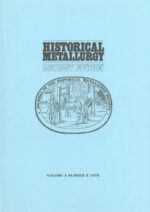Journal Contents
Bronze Age crucibles from the Kastro-Palaia settlement, Volos, Greece - a contradiction of form and function?
T Rehren, E Asderaki, E Skafida and A Karnava
Pages 111-124
We present several cmciblefragmentsfrom Bronze Age contexts in Volos, Greece, linked to a Late Bronze Age (Mycenaean) palace workshop and its predecessor building. Two of the crucibles have side sockets for manipulation, and all are internallyfired. Chemical analyses ofmetallurgical remains from within the crucibles indicate the range ofalloy compositions for which they were used, including arsenical copper and tin bronze. Lead isotope ratio analyses point to multiple sources of copper, as would be expected over the extended time period that these fragments represent.
A question of grey or white: Why Abraham Darby I chose to smelt iron with coke
Richard Williams
Pages 125-137
The tendency for an iron to solidify white or grey on coming out of a blast fiirnace in the 17th and 18th centuries is reviewed and quantified. It is demonstrated that iron from a charcoal blastfurnace could not produce the necessary grey iron in a thin-walled cooking pot cast in a cold mould. Charcoal iron masters therefore had to pour their metal into heated moulds, which obliged them to use the costly loam moulding process. Abraham Darby’s great breakthrough was realising that iron made with coke could produce a grey iron pot in a cold mould, which allowed him to use the much cheaper green sand process. His patent tells us he realized this several years before moving to Coalbrookdale. Part of the evidence for this assertion involves identifying castings made with each process. A pot in the Ironbridge Gorge Museum is identified as the oldest known coke-iron casting made in the western world.
18th-century ironfounding: coke iron, air furnaces and cupolas
Peter King
Pages 138-145
The foundry trade developed as a separate branch of the iron industry in the first half of the 18th century. It mostly used coke pig iron, which was produced at Coalbrookdale and in a small number of other furnaces. This was rendered possible by Sir Clement Clerke’s development of the air furnace for remelting pig iron and of Abraham Darby’s patented method of casting pots in green sand. This paper considers the spread of coke smelting and of foundries with air furnaces in the 18th century, which are closely related to each other. It ends by looking briefly at unresolved issues in the origins of the later foundry cupola.
Naval metals from mid 18th- to early 19th-century European shipwrecks: a first analytical approach
Nicolás C Ciarlo
Pages 146-152
This article gives the preliminary results of a study of metal artefacts recovered from European shipwrecks dating from the mid 18th- to early 19th-century. The analytical approach included optical emission spectrometry (OES), atomic absorption spectrometry (AAS) and infrared spectroscopy (IR) which determined the main constituents and trace element contents of the materials. Based on the latter, and other sources of information, a technological assessment was peiformed. Such data provides information on the functionality of artefacts, the quality of the alloys and their possible provenance.
Determination of the mechanical properties of historic wrought iron wire from the Wheeling Suspension Bridge main cable
K V Organ, W L Elban and R E Smelser
Pages 153-162.
The mechanical responses of two different segments of historic wrought iron wire, designated WSB-2 and WSB-3, used in the construction of the main cables of the Wheeling Suspension Bridge were characterized. Evaluation of the elastic modulus was accomplished using a double pendulum test. From the stress-strain responses obtainedfrom standard uniaxial tensile testing, values of yield stress, ultimate tensile strength, failure stress, failure strain, and percent reduction-in-area at failure were determined. While there were only small differences in most of these values for the two materials, WSB-2 was 10.5% stijfer and had a 23.4%) higher failure stress. Both wires were found to be in an essentially fully work hardened state. Two graphical tensile strength versus indentation hardness correlations for historic wrought iron were also developed and evaluated.





There are no reviews yet.